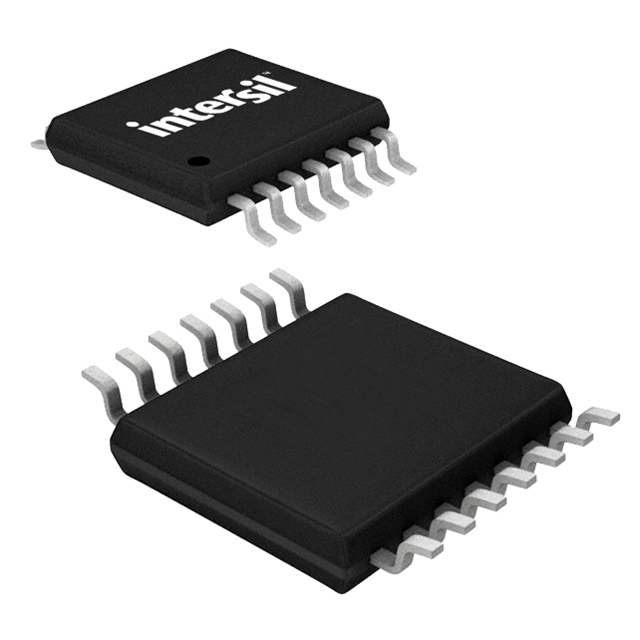Consulte las especificaciones para obtener detalles del producto.

X9420WV14ZT1
Product Overview
- Category: Electronic Component
- Use: Digital Potentiometer
- Characteristics:
- High precision
- Wide resistance range
- Non-volatile memory
- Low power consumption
- Package: Surface Mount Technology (SMT)
- Essence: Integrated circuit for digital potentiometer functionality
- Packaging/Quantity: Tape and reel, 250 units per reel
Specifications
- Resistance Range: 0Ω to 100kΩ
- Resolution: 256 steps
- Operating Voltage: 2.7V to 5.5V
- Temperature Range: -40°C to +85°C
- Interface: Serial Peripheral Interface (SPI)
- Memory Type: Non-volatile Electrically Erasable Programmable Read-Only Memory (EEPROM)
Detailed Pin Configuration
The X9420WV14ZT1 has the following pin configuration:
| Pin Number | Pin Name | Description | |------------|----------|-------------| | 1 | VCC | Power Supply Voltage | | 2 | GND | Ground | | 3 | CS | Chip Select | | 4 | SCK | Serial Clock | | 5 | SI | Serial Data Input | | 6 | SO | Serial Data Output | | 7 | WP | Write Protect | | 8 | H | Terminal A of Potentiometer | | 9 | W | Wiper Terminal of Potentiometer | | 10 | L | Terminal B of Potentiometer |
Functional Features
- Adjustable resistance through digital control
- Non-volatile memory retains settings even when power is disconnected
- SPI interface allows easy integration with microcontrollers
- High precision and resolution for accurate adjustments
- Low power consumption for energy-efficient applications
Advantages and Disadvantages
Advantages: - Wide resistance range suits various applications - Non-volatile memory eliminates the need for external storage - High precision ensures accurate resistance settings - Low power consumption prolongs battery life
Disadvantages: - Limited to digital control, not suitable for analog applications - Requires a microcontroller or SPI interface for operation
Working Principles
The X9420WV14ZT1 is based on the principle of a digital potentiometer. It consists of a resistive element divided into three terminals - A, W, and B. The wiper terminal (W) can be moved digitally along the resistive element, effectively changing the resistance between terminals A and W or W and B.
The position of the wiper is controlled by the digital inputs provided through the SPI interface. The non-volatile memory ensures that the wiper position is retained even when power is disconnected.
Detailed Application Field Plans
The X9420WV14ZT1 finds applications in various fields, including:
- Audio Equipment: Volume control, tone adjustment
- Industrial Automation: Calibration, signal conditioning
- Test and Measurement Instruments: Fine-tuning, calibration
- Communication Systems: Signal processing, gain control
- Consumer Electronics: Display brightness control, user interface adjustment
Detailed and Complete Alternative Models
- X9420WV14ZT2: Similar specifications, different package (Through-Hole)
- X9420WV14ZT3: Higher resistance range (0Ω to 1MΩ), same package
- X9420WV14ZT4: Lower power consumption, same specifications
(Note: Please refer to the manufacturer's datasheet for a comprehensive list of alternative models)
This entry provides an overview of the X9420WV14ZT1 digital potentiometer. It includes information about its category, use, characteristics, package, specifications, pin configuration, functional features, advantages and disadvantages, working principles, application field plans, and alternative models.
Enumere 10 preguntas y respuestas comunes relacionadas con la aplicación de X9420WV14ZT1 en soluciones técnicas
Sure! Here are 10 common questions and answers related to the application of X9420WV14ZT1 in technical solutions:
Q1: What is X9420WV14ZT1? A1: X9420WV14ZT1 is a specific model of integrated circuit (IC) or chip used in various technical solutions.
Q2: What are the key features of X9420WV14ZT1? A2: Some key features of X9420WV14ZT1 include non-volatile memory, digital potentiometer functionality, and a wide operating voltage range.
Q3: How can X9420WV14ZT1 be used in technical solutions? A3: X9420WV14ZT1 can be used as a programmable resistor or variable resistor in electronic circuits, allowing for digital control of resistance values.
Q4: What is the operating voltage range of X9420WV14ZT1? A4: The operating voltage range of X9420WV14ZT1 typically spans from 2.7V to 5.5V.
Q5: Can X9420WV14ZT1 be used in low-power applications? A5: Yes, X9420WV14ZT1 is designed to operate with low power consumption, making it suitable for battery-powered devices or energy-efficient systems.
Q6: Is X9420WV14ZT1 compatible with standard microcontrollers? A6: Yes, X9420WV14ZT1 can be easily interfaced with standard microcontrollers using common communication protocols such as I2C or SPI.
Q7: Can X9420WV14ZT1 store its settings even when powered off? A7: Yes, X9420WV14ZT1 has non-volatile memory, allowing it to retain its programmed settings even when the power is disconnected.
Q8: What is the resolution of X9420WV14ZT1? A8: The resolution of X9420WV14ZT1 refers to the number of distinct resistance values it can provide. It typically has a resolution of 256 or higher.
Q9: Can X9420WV14ZT1 be used in audio applications? A9: Yes, X9420WV14ZT1 can be used in audio applications for volume control, tone adjustment, or other purposes where variable resistance is required.
Q10: Are there any specific precautions to consider when using X9420WV14ZT1? A10: It is important to follow the manufacturer's guidelines and datasheet for proper usage of X9420WV14ZT1, including voltage limits, temperature range, and recommended soldering techniques.
Please note that the answers provided here are general and may vary depending on the specific application and requirements.

